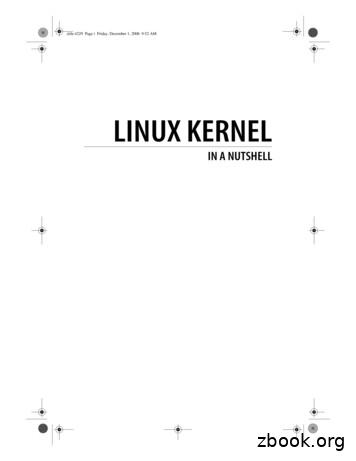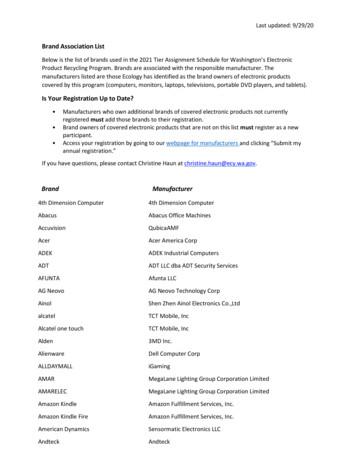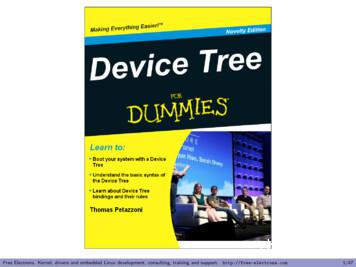Embedded Linux Getting Started Guide - Intel
Embedded Linux Getting Started Guide GSG-Linux-VT-2.01 User Guide Document Revision History Date March 8, 2013 2013 Altera Corporation Version 1.0 Description Released
Page 2 Contents Document Revision History. 1 Overview . 3 Introduction. 3 Release Contents and Location . 3 Prerequisites. 4 Build Yocto . 5 Host Setup . 5 CentOS . 5 Ubuntu . 5 Setup Yocto . 6 Build kernel/rootfs/u-boot . 6 Programming Flash . 8 Requirements . 8 Usage . 8 Booting Linux on the SoC FPGA CV Devkit . 11 “Hello World” Linux application using solo Linaro toolchain . 15 Build “Hello World” Linux application. 15 Debug “Hello World” Linux application . 16 March 2013 Altera Corporation
Page 3 Overview Introduction This document walks through the basic software flow to have a “Hello World” Linux application running on the Cortex-A9 processors in the Cyclone V SoC FPGA development kit. This guide focuses purely on getting a basic Linux application running and has no interaction with programmable logic (FPGA) portion of SoC FPGA. Hence, to simplify things, we use: No FPGA design Pre-built bootloader/Linux software images for the Cyclone V SoC FPGA development kit For topics such as hardware flow for custom logic and preloader customization, please see other documentations such as “Golden System Reference Design User Guide”. Release Contents and Location Altera provides Linux BSP support for the Cyclone V SoC FPGA Development Kit, and provides the following: Linux kernel 3.7 Preloader u-boot version 2012.10 Yocto version 'Danny' The packages for the root file system. The tool chain (Linaro-GCC, v4.7) Yocto is used to build the sources of the kernel, the u-boot and the root file system. There are many source code packages available under the Yocto project. Should you enable a package that is not provided with our BSP, it will be downloaded (SVN, GIT, etc). If you are behind a proxy, you need to make sure the network configuration of your Linux host is ready. The Linux BSP release is composed of three packages: documentation, sources and binaries. Package Name Contents linux-socfpga-13.02-src.bsx Source code (self extracting) linux-socfpga-13.02-bin.tar.gz Binaries Embedded Linux Getting Started Guide (this doc) Linux BSP User Manual - 13.02.pdf Linux BSP Release Notes - 13.02.pdf Documentation Yocto Danny User Manual - 13.02.pdf March 2013 Altera Corporation
Page 4 You can find the release at: http://software.altera.com/linux socfpga. Prerequisites SoC EDS 13.0 or above installed from (http://software.altera.com/soceds) March 2013 Altera Corporation
Page 5 Build Yocto Host Setup The recommended development platform is a PC computer with minimum 2GB RAM and 20GB hard drive, with one of the following OS-es installed: CentOS 6.3, Ubuntu 12.04 LTS. We have tested the Yocto package with above distributions. Be warned that Ubuntu has been tested with Yocto but is not an officially supported distribution for Altera ACDS. Other distributions may work as well but not guaranteed to be work-free. Generally the latest version is preferred. CentOS These are the required packages that need to be installed on a fresh DVD-based installation of CentOS 6.3. If a different installation method was used (e.g. from a CD) then more packages might be necessary. sudo yum update sudo yum groupinstall "Development Tools" sudo yum install texi2html texinfo glibc-devel chrpath If the host machine runs the 64bit version of the OS, then the following additional packages need to be installed: sudo yum install glibc.i686 libgcc.i686 libstdc .i686 glibcdevel.i686 ncurses-libs.i686 zlib.i686 Ubuntu These are the required packages that need to be installed on a fresh DVD-based installation of Ubuntu 12.04 LTS. sudo apt-get update sudo apt-get upgrade sudo apt-get install sed wget cvs subversion git-core coreutils unzip texi2html texinfo libsdl1.2-dev docbook-utils gawk python-pysqlite2 diffstat help2man make gcc build-essential g desktop-file-utils chrpath libgl1-mesa-dev libglu1-mesa-dev mercurial autoconf automake groff libtool xterm sudo apt-get install uboot-mkimage March 2013 Altera Corporation
Page 6 If a different installation method was used (e.g from a CD) then more packages might be necessary. If the host machine runs the 64bit version of the OS, then the following additional packages need to be installed: sudo apt-get install ia32-libs Setup Yocto 1. Download the linux-socfpga-13.02-src.bsx source package. 2. Install the package. It should be installed in a publicly accessible location, as this step can be shared by all users on the system (or on the filesystem if your company is using a network share). The default install location is /opt/altera-linux. However, if you wish to use this location, you will likely need root access in order to access this directory. path to downloaded file /linux-socfpga-13.02-src.bsx /opt/altera-linux 3. Install a local set of yocto recipes. This could be done in a shared location, but if someone wants or needs to modify them they should have their own version. The default install location for this is within your home directory. /opt/altera-linux/bin/install altera socfpga src.sh /yocto13.02 4. Create a build directory. By keeping this separate from your yocto source you can erase your entire build without fear of deleting your yocto sources. Also, you can have several build directories, each with its own configuration, all based on the same yocto source. The script serves 2 purposes. First, it creates the new build directory using Altera’s default configuration. Secondly, it sets some shell variables that are required for building. If you start a new shell you will need to run these commands to set these shell variables again. cd /yocto-13.02/ source altera-init /yocto-13.02/build Build kernel/rootfs/u-boot In order to build u-boot from within the build directory: bitbake u-boot In order to build linux from within the build directory: bitbake linux-altera In order to build the root filesystem: March 2013 Altera Corporation
Page 7 bitbake altera-image The first time may take up to several hours depending on your host machine. Once finished, all images should be generated in /build/tmp/deploy/images. March 2013 Altera Corporation
Page 8 Programming Flash To boot the linux images on SoC FPGA development kit, you need to write the images you just built with Yocto into one of the three Flash devices: SDMMC, NAND and QSPI. For this guide, we will use SDMMC due to its easy detachability. For SDMMC boot, all boot images will be located inside SD/MMC card. A script is provided with the release that will create an SD card image, ready to be deployed. Requirements The script relies on a tool, named mkpimage, which creates the correct preloader image that the SoCFPGA Boot ROM accepts. This tool is provided with the SoCEDS release and must be on your search path (PATH). To find out, run: which mkpimage The SoC EDS toolset provides the embedded command shell.sh script that sets all necessary PATH entries for the included tools. Please run it if the mkpimage is not in the PATH. The SD image script needs to be run with root privileges, using sudo command. By default, when sudo is invoked, it uses a default PATH variable, which may not have the SoC EDS PATH entries. In this case the tool would fail reporting it could not find the mkpimage tool. In order to avoid this problem, please instruct sudo to preserve the current PATH, by executing the following command: sudo viso and removing resetting environment and adding the PATH to the list of environment variables to be kept: #Defaults env reset Defaults env keep ". PATH" Alternatively the sudo can be instructed from command line to keep the current path: sudo PAT PATH Usage The provided tool, named make sdimage.sh, will create a 2GB SD card image, with three partitions: p1, being a FAT partition when the kernel and the device tree are located, p2, the Linux root file system, as an ext3 partition, March 2013 Altera Corporation
Page 9 p3, the partition used by the SoCFPGA ROM to load the preloader. The same partition is used by the preloader to load the u-boot image. Here's how the script is used: sudo make sdimage.sh \ -k uImage,socfpga.dtb \ -p u-boot-spl-socfpga cyclone5.bin \ -b u-boot-socfpga cyclone5.img \ -r fs \ -o sd image.bin Where: -k accepts a comma separated list of files. Here, we show the kernel and the device tree blob. -p the preloader raw binary, as generated by Yocto or the U-Boot Makefile -b the bootloader image, as generated by Yocto or the U-Boot Makefile -r the directory where the file system is located. -o the image name In case you need help, please run: make sdimage.sh -h. The following presents a complete script usage: cd /yocto/build/tmp/deploy/images sudo /opt/altera-linux/bin/make sdimage.sh \ -k uImage,socfpga cyclone5.dtb \ -p u-boot-spl-socfpga cyclone5.bin \ -b u-boot-socfpga cyclone5.img \ -r /yocto/build/tmp/work/socfpga tfs \ -o sd image.bin The log messages will be similar with the following: make sdimage.sh: info: creating image file. make sdimage.sh: info: creating partition table. make sdimage.sh: info: clean up. make sdimage.sh: info: creating preloader/bootloader image. make preloader img.sh: info: using preloader -splsocfpga cyclone5.bin make preloader img.sh: info: clean up. March 2013 Altera Corporation
Page 10 make preloader img.sh: make sdimage.sh: info: partition. make sdimage.sh: info: make sdimage.sh: info: make sdimage.sh: info: March 2013 info: done. copying preloader image and bootloader to copying OS files, etc. creating root file system. cleaning up (rfs). Altera Corporation
Page 11 Booting Linux on the SoC FPGA CV Devkit 1. Make sure that following shunts/shorting jumpers are installed as described below. Pictures are shown for clarity here as well. Clock select CLKSELx: o J26, J27: set toward the power switch Boot select BOOTSELx: o J28, J29: set toward the power switch o J30: set away from the power switch Rest of jumper settings: Number J5 J6 J8 J9 J13 J15 J31 March 2013 Name 9V JTAG HPS SEL JTAG SEL UART Signals OSC1 CLK SEL JTAG MIC SEL SPI I2C Setting Open Open Shorted Open Shorted Open Open Altera Corporation
Page 12 2. Make sure the DIP switches are configured as described below and shown in the following pictures: SW1 all switches set toward the board edge. SW2 all switches set away from the corner of the board. SW3 all switches set toward the board edge. SW4 JTAG ENABLE. o Each switch enables a connection to the scan chain when its corresponding switch is set away from the board edge (off). o Set for programming the FPGA using the on-board USB Blaster II ON/OFF/ON/OFF, leaving the FPGA and MAX connected to JTAG. March 2013 Altera Corporation
Page 13 3. Use a mini-USB to USB cable to connect “UART” on the board to the host PC (May need to install Cypress UART-to-USB driver) 4. Power on the board (19V power supply!) 5. Open a serial terminal program (i.e. minicom) and set the baudrate to 57600/8-N-1 6. With the microSD card slotted in, observe Linux booting on the UART console. March 2013 Altera Corporation
Page 14 7. Login as “root” with no password and you are good to go! March 2013 Altera Corporation
Page 15 “Hello World” Linux application using solo Linaro toolchain Build “Hello World” Linux application 1. In your host linux machine, write a simple Hello World application called helloworld.c #include stdio.h int main(int argc, void** argv){ printf(“Hello World!\n”); return 0; } 2. Set up linux host environment for linaro cross-compiler. Ex % export PATH your extracted bsp package location 20121123 linux/bin : PATH An example of the command if you installed at the default /opt/altera-linux: % export PATH bihf-4.7-2012.11-20121123 linux/bin: PATH 3. Build helloworld.c with the Linaro cross-compiler % arm-linux-gnueabihf-gcc –o helloworld helloworld.c 4. Connect the target board to the same network as your host machine 5. Set up Ethernet interface on the target (if the DHCP server in your network did not automatically configured an IP address) % ifconfig eth0 static IP address in the same subnet as your host machine and not used 6. Set up TFTP server on the host and copy helloworld ELF file to the server folder (e.g. /tftpboot) 7. Transfer helloworld ELF to the running eLinux by issuing following command on the target % tftp –g host IP -r helloworld 8. Run helloworld on the target: % chmod x helloworld March 2013 Altera Corporation
Page 16 % ./helloworld Debug “Hello World” Linux application 1. Run GDBSERVER on the helloworld ELF in the target % cd directory of helloworld ELF % /usr/bin/gdbserver host: port of your choice ./helloworld 2. Run GDB client in the host % cd directory of helloworld ELF % arm-linux-gnueabihf-gdb ./helloworld 3. In GDB command line, connect to the target via TCP/IP % target remote target IP : the port you chose 4. Now you can use execute standard GDB operations such as breakpoint and single stepping. Typical commands are: ‘s’ for step into a function ‘n’ for next instruction ‘b’ for breakpoint March 2013 Altera Corporation
The Linux BSP release is composed of three packages: documentation, sources and binaries. Package Name Contents linux-socfpga-13.02 -src.bsx Source code (self extracting) linux-socfpga-13.02 -bin.tar.gz Binaries Embedded Linux Getting Started Guide (this doc) Documentation Linux BSP User Manual - 13.02.pdf Linux BSP Release Notes
Linux in a Nutshell Linux Network Administrator’s Guide Linux Pocket Guide Linux Security Cookbook Linux Server Hacks Linux Server Security Running Linux SELinux Understanding Linux Network Internals Linux Books Resource Center linux.oreilly.comis a complete catalog of O’Reilly’s books on Linux and Unix and related technologies .
Other Linux resources from O’Reilly Related titles Building Embedded Linux Systems Linux Device Drivers Linux in a Nutshell Linux Pocket Guide Running Linux Understanding Linux Network Internals Understanding the Linux Kernel Linux Books Resource Center linu
Chapter 1: Getting started with embedded-linux Remarks This section provides an overview of what embedded-linux is, and why a developer might want to use it. It should also mention any large subjects within embedded-linux, and link out to the related topics. Since the Documentation for embedded-linux is new, you may need to create initial .
Perfection PC Perfection PC Inc. Philips Philips Electronics Planar Planar Systems Inc PLEXON Plexon, Inc. Pogo Linux Pogo Linux, Inc. Pogo Linux Altura M2 Pogo Linux, Inc. Pogo Linux Velocity -D50 Pogo Linux, Inc. Pogo Linux Verona 330 Pogo Linux, Inc. Pogo Linux Vor
Thomas Petazzoni I CTO and Embedded Linux engineer at Free Electrons I Embedded Linux development: kernel and driver development, system integration, boot time and power consumption optimization, consulting, etc. I Embedded Linux training, Linux driver development training and Android system development training, with materialsFile Size: 1MB
Advanced Linux Programming Contents At a Glance I Advanced UNIX Programming with Linux 1 Getting Started 3 2 Writing Good GNU/Linux Software 17 3 Processes 45 4 Threads 61 5 Interprocess Communication95 II Mastering Linux 6 Devices 129 7 The /proc File System 147 8 Linux System Calls 167 9 Inline Assembly Code 189 10 Security 197 11 A Sample GNU/Linux Application 219 III
Yes. Oracle Autonomous Linux, which is based on Oracle Linux, is 100% application binary compatible with IBM's Red Hat Enterprise Linux. This means that applications certified to run on Red Hat Enterprise Linux can run on Oracle Autonomous Linux unmodified. Oracle Linux binaries are provided for patching and updating Red Hat Enterprise Linux
Advanced Engineering Mathematics 6. Laplace transforms 21 Ex.8. Advanced Engineering Mathematics 6. Laplace transforms 22 Shifted data problem an initial value problem with initial conditions refer to some later constant instead of t 0. For example, y” ay‘ by r(t), y(t1) k1, y‘(t1) k2. Ex.9. step 1.























